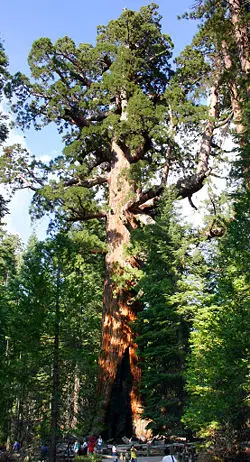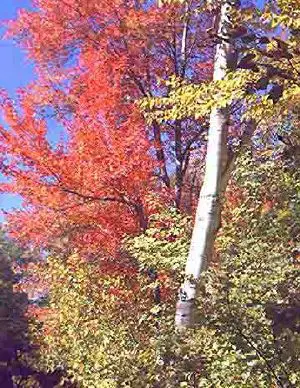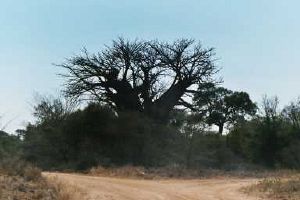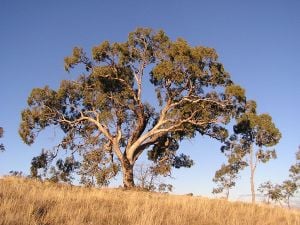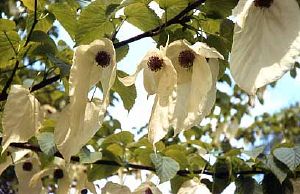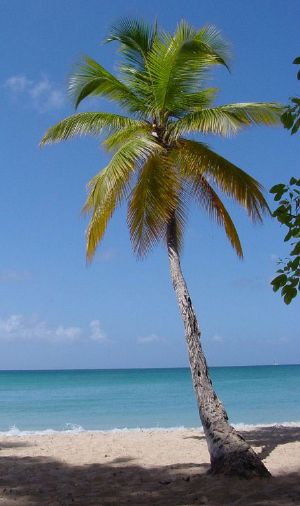Difference between revisions of "Tree" - New World Encyclopedia
| Line 10: | Line 10: | ||
'''Conifers''' do not have true flowers and bear their single-lobed seeds "naked", not covered in a fruit or seed case. In most cases their leaves are small and needle-like. They include pines, firs, cypresses, and others. Most conifers grow in the Northern Hemisphere through the temperate zone north to around the Arctic Circle. Almost all of them are evergreen. | '''Conifers''' do not have true flowers and bear their single-lobed seeds "naked", not covered in a fruit or seed case. In most cases their leaves are small and needle-like. They include pines, firs, cypresses, and others. Most conifers grow in the Northern Hemisphere through the temperate zone north to around the Arctic Circle. Almost all of them are evergreen. | ||
| − | '''Palms''' are the third largest tree group. They grow mostly in the tropics and are distinctive for not having branches, the large leaves grow directly from the top of the trunk | + | '''Palms''' are the third largest tree group. They grow mostly in the tropics and are distinctive for not having branches, the large leaves grow directly from the top of the trunk, and for growing "from the inside out." Smaller tree groups include members of the '''Agave''' family and the '''Cycad''' family and the '''ginkgo''' and '''tree ferns'''. The '''saguaro cactus''' and some species of '''bamboo''' (a [[grass]]) are sometimes considered to be trees because of their size. |
| − | == | + | ==Forests== |
| − | |||
| − | |||
| − | + | A '''forest''' is an area with many trees and in which they are the dominant influence. Most trees grow in forests. There are different types of forests around the world mainly depending on the climate. | |
===Tropical Rain Forests=== | ===Tropical Rain Forests=== | ||
===Tropical Seasonal Forests=== | ===Tropical Seasonal Forests=== | ||
| Line 23: | Line 21: | ||
===Boreal Forests=== | ===Boreal Forests=== | ||
===Savannnas=== | ===Savannnas=== | ||
| + | |||
| + | ==The Importance of Trees== | ||
| + | |||
| + | Trees, like all plants, capture the energy of sunlight and convert it into chemical energy which they use for their own growth and life processes. This energy is passed on supporting a large community of living things. Many animals eat the fruits, seeds, leaves, sap, or even the wood of trees. On the forest floor the fallen leaves decompose supporting micro-organisms, mushrooms, worms, insects, and others. A layer of soil is built up and protected by the trees' roots. Trees help to modify the climate providing shade in hot weather and shelter from the wind. In some cases they increase the rainfall or capture moisture from fog. The forest floor holds water from rain and snow helping to lessen the effects of flooding and drought. | ||
| + | |||
| + | |||
==Trees and Humans== | ==Trees and Humans== | ||
| Line 30: | Line 34: | ||
====Deforestation==== | ====Deforestation==== | ||
====Cultivation of Trees==== | ====Cultivation of Trees==== | ||
| − | + | People, from prehistoric times, have planted and protected trees which they have found useful. Over time these tree species have been modified by human selection and new varieties have come into being. They have also been planted in new places. Some of the earliest cultivated trees are the apple from Central Asia, the fig and the date palm from Western Asia, the mango from India, and the olive from the Mediterranean. The origins of the coconut are unknown but it was spread world-wide by the Polynesians and other sea-faring peoples. Cocao and avacado trees were first cultivated in the New World. This process has greatly accelerated in modern times and many species of trees which people find useful or beautiful have been transplanted and are now growing far from their origins. | |
====Conservation and Reforestation==== | ====Conservation and Reforestation==== | ||
Revision as of 07:25, 18 May 2006
Trees are the largest plants. They are not a single family but include members of many plant families. A tree can be defined as a perennial (living more than one or two years) plant growing at least 6 meters (20 feet), or so, tall. It must be supported by a single woody trunk which can stand on its own.
Trees have a tremendous importance for other plants, for animals; for the entire web of life on earth, including humans.
Types of Trees
Most trees are classified as either broadleaf or conifer. Broadleafs are flowering plants which bear two-lobed seeds inside of fruits or seed cases. They include oaks, willows, apple trees, magnolia, eucalyptus; and many others. Broadleafs grow mainly from the tropics through the temperate zones in both the Southern and the Northern Hemispheres. Most in the tropics and subtropics are evergreen, keeping their leaves until new ones replace them; while most in colder regions are deciduous, losing their leaves in fall and growing new ones in spring each year.
Conifers do not have true flowers and bear their single-lobed seeds "naked", not covered in a fruit or seed case. In most cases their leaves are small and needle-like. They include pines, firs, cypresses, and others. Most conifers grow in the Northern Hemisphere through the temperate zone north to around the Arctic Circle. Almost all of them are evergreen.
Palms are the third largest tree group. They grow mostly in the tropics and are distinctive for not having branches, the large leaves grow directly from the top of the trunk, and for growing "from the inside out." Smaller tree groups include members of the Agave family and the Cycad family and the ginkgo and tree ferns. The saguaro cactus and some species of bamboo (a grass) are sometimes considered to be trees because of their size.
Forests
A forest is an area with many trees and in which they are the dominant influence. Most trees grow in forests. There are different types of forests around the world mainly depending on the climate.
Tropical Rain Forests
Tropical Seasonal Forests
Temperate Deciduous Forests
Temperate Evergreen Forests
Boreal Forests
Savannnas
The Importance of Trees
Trees, like all plants, capture the energy of sunlight and convert it into chemical energy which they use for their own growth and life processes. This energy is passed on supporting a large community of living things. Many animals eat the fruits, seeds, leaves, sap, or even the wood of trees. On the forest floor the fallen leaves decompose supporting micro-organisms, mushrooms, worms, insects, and others. A layer of soil is built up and protected by the trees' roots. Trees help to modify the climate providing shade in hot weather and shelter from the wind. In some cases they increase the rainfall or capture moisture from fog. The forest floor holds water from rain and snow helping to lessen the effects of flooding and drought.
Trees and Humans
Benefits of Trees to Humans
Human Effect on Trees
Deforestation
Cultivation of Trees
People, from prehistoric times, have planted and protected trees which they have found useful. Over time these tree species have been modified by human selection and new varieties have come into being. They have also been planted in new places. Some of the earliest cultivated trees are the apple from Central Asia, the fig and the date palm from Western Asia, the mango from India, and the olive from the Mediterranean. The origins of the coconut are unknown but it was spread world-wide by the Polynesians and other sea-faring peoples. Cocao and avacado trees were first cultivated in the New World. This process has greatly accelerated in modern times and many species of trees which people find useful or beautiful have been transplanted and are now growing far from their origins.
Conservation and Reforestation
Major tree genera
Flowering plants (Magnoliophyta; angiosperms)
Dicotyledons (Magnoliopsida; broadleaf or hardwood trees)
- Altingiaceae (Sweetgum family)
- Sweetgum, Liquidambar species
- Anacardiaceae (Cashew family)
- Annonaceae (Custard apple family)
- Cherimoya Annona cherimola
- Custard apple Annona reticulata
- Pawpaw Asimina triloba
- Soursop Annona muricata
- Apocynaceae (Dogbane family)
- Pachypodium Pachypodium species
- Aquifoliaceae (Holly family)
- Holly, Ilex species
- Araliaceae (Ivy family)
- Kalopanax, Kalopanax pictus
- Betulaceae (Birch family)
- Bignoniaceae (family)
- Catalpa, Catalpa species
- Cactaceae (Cactus family)
- Saguaro, Carnegiea gigantea
- Cannabaceae (Cannabis family)
- Hackberry, Celtis species
- Cornaceae (Dogwood family)
- Dogwood, Cornus species
- Dipterocarpaceae family
- Garjan Dipterocarpus species
- Sal Shorea species
- Ericaceae (Heath family)
- Arbutus, Arbutus species
- Eucommiaceae (Eucommia family)
- Eucommia Eucommia ulmoides
- Fabaceae (Pea family)
- Acacia, Acacia species
- Honey locust, Gleditsia triacanthos
- Black locust, Robinia pseudoacacia
- Laburnum, Laburnum species
- Pau Brasil, Brazilwood, Caesalpinia echinata
- Fagaceae (Beech family )
- Fouquieriaceae (Boojum family)
- Boojum, Fouquieria columnaris
- Hamamelidaceae (Witch-hazel family)
- Persian Ironwood, Parrotia persica
- Juglandaceae (Walnut family)
- Lauraceae (Laurel family)
- Lecythidaceae (Paradise nut family)
- Brazil Nut Bertholletia excelsa
- Lythraceae Loosestrife family
- Crape-myrtle Lagerstroemia species
- Magnoliaceae (Magnolia family)
- Tulip tree, Liriodendron species
- Magnolia, Magnolia species
- Malvaceae (Mallow family; including Tiliaceae and Bombacaceae)
- Meliaceae (Mahogany family)
- Neem, Azadirachta indica
- Bead tree, Melia azedarach
- Mahogany, Swietenia mahagoni
- Moraceae (Mulberry family) Eucalyptus bridgesiana on Red Hill, Australian Capital Territory.
- Myristicaceae (Nutmeg family)
- Nutmeg, Mysristica fragrans
- Myrtaceae (Myrtle family)
- Eucalyptus, Eucalyptus species
- Myrtle, Myrtus species
- Guava, Psidium guajava
- Nyssaceae (Tupelo family; sometimes included in Cornaceae)
- Tupelo, Nyssa species
- Dove tree, Davidia involucrata
- Oleaceae (Olive family)
- Olive, Olea europaea
- Ash, Fraxinus species
- Paulowniaceae (Paulownia family)
- Foxglove Tree, Paulownia species
- Platanaceae (Plane family)
- Plane, Platanus species
- Rhizophoraceae (Mangrove family)
- Red Mangrove, Rhizophora mangle
- Rosaceae (Rose family)
- Rubiaceae (Bedstraw family)
- Coffee, Coffea species
- Rutaceae (Rue family)
- Citrus, Citrus species
- Cork-tree, Phellodendron species
- Euodia, Tetradium species
- Salicaceae (Willow family)
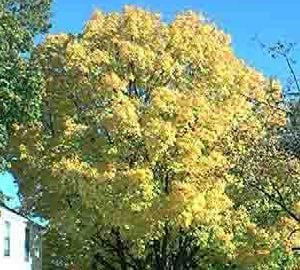
- Sapindaceae (including Aceraceae, Hippocastanaceae) (Soapberry family)
- Maple, Acer species
- Buckeye, Horse-chestnut, Aesculus species
- Mexican Buckeye, Ungnadia speciosa
- Lychee, Litchi sinensis
- Golden rain tree, Koelreuteria
- Sapotaceae (Sapodilla family)
- Argan, Argania spinosa
- Gutta-percha, Palaquium species
- Tambalacoque, or "dodo tree", Sideroxylon grandiflorum, previously Calvaria major
- Simaroubaceae family
- Tree of heaven, Ailanthus species
- Theaceae (Camellia family)
- Gordonia, Gordonia species
- Stuartia, Stuartia species
- Thymelaeaceae (Thymelaea family)
- Ramin, Gonystylus species
- Ulmaceae (Elm family)
- Elm, Ulmus species
- Zelkova, Zelkova species
- Verbenaceae family
- Teak, Tectona species
Monocotyledons (Liliopsida)
- Agavaceae (Agave family)
- Cabbage tree, Cordyline australis
- Dragon tree, Dracaena draco
- Joshua tree, Yucca brevifolia
- Arecaceae (Palmae) (Palm family)
- Areca Nut, Areca catechu
- Coconut Cocos nucifera
- Date Palm, Phoenix dactylifera
- Chusan Palm, Trachycarpus fortunei
- Poaceae (grass family)
- Bamboos Poaceae subfamily Bambusoideae
- Note that banana 'trees' are not actually trees; they are not woody nor is the stalk perennial.
Conifers (Pinophyta; softwood trees)
- Araucariaceae (Araucaria family)
- Araucaria, Araucaria species
- Kauri, Agathis species
- Wollemia, Wollemia nobilis
- Cupressaceae (Cypress family)
- Cypress, Cupressus species
- Cypress, Chamaecyparis species
- Juniper, Juniperus species
- Alerce or Patagonian cypress, Fitzroya cupressoides
- Sugi, Cryptomeria japonica
- Coast Redwood, Sequoia sempervirens
- Giant Sequoia, Sequoiadendron giganteum
- Dawn Redwood, Metasequoia glyptostroboides
- Western Redcedar Thuja plicata
- Bald Cypress, Taxodium species
- Pinaceae (Pine family)
- Podocarpaceae (Yellowwood family)
- African Yellowwood, Afrocarpus falcatus
- Totara, Podocarpus totara
- Miro, Prumnopitys ferruginea
- Kahikatea, Dacrycarpus dacrydioides
- Rimu, Dacrydium cupressinum
- Sciadopityaceae,
- Kusamaki, Sciadopitys species
- Taxaceae (Yew family)
- Yew, Taxus species
Ginkgos (Ginkgophyta)
- Ginkgoaceae (Ginkgo family)
- Ginkgo, Ginkgo biloba
Cycads (Cycadophyta)
Ferns (Pterophyta)
- Cyatheaceae and Dicksoniaceae families
- Tree ferns, Cyathea, Alsophila, Dicksonia (not a monophyletic group)
Champion trees
The world's champion trees can be considered on several factors; height, trunk diameter or girth, total size, and age. It is significant that in each case, the top position is always held by a conifer, though a different species in each case; in most measures, the second to fourth places are also held by conifers.
- Tallest trees
The heights of the tallest trees in the world have been the subject of considerable dispute and much (often wild) exaggeration. Modern verified measurement with laser rangefinders combined with tape drop measurements made by tree climbers, carried out by the U.S. Eastern Native Tree Society has shown that most older measuring methods and measurements are unreliable, often producing exaggerations of 5% to 15% above the real height. Historical claims of trees of 114 m, 117 m, 130 m, and even 150 m, are now largely disregarded as unreliable, fantasy or outright fraud. The following are now accepted as the top five tallest reliably measured species:
- Coast Redwood Sequoia sempervirens: 112.83 m, Humboldt Redwoods State Park, California (Gymnosperm Database)
- Coast Douglas-fir Pseudotsuga menziesii: 100.3 m, Brummit Creek, Coos County, Oregon (Gymnosperm Database)
- Sitka Spruce Picea sitchensis: 96.7 m, Prairie Creek Redwoods State Park, California (Gymnosperm Database)
- Giant Sequoia Sequoiadendron giganteum: 93.6 m, Redwood Mountain Grove, California (Gymnosperm Database)
- Australian Mountain-ash Eucalyptus regnans: 92.0 m, Styx Valley, Tasmania (Forestry Tasmania [pdf file])
- Stoutest trees
The girth (circumference) of a tree is – or at least should be – much easier to measure than the height, as it is a simple matter of stretching a tape round the trunk, and pulling it taut to find the circumference. Despite this, U.K. tree author Alan Mitchell made the following comment about measurements of yew trees in the British Isles:
- "The aberrations of past measurements of yews are beyond belief. For example, the tree at Tisbury has a well-defined, clean, if irregular bole at least 1.5 m long. It has been found to have a girth which has dilated and shrunk in the following way: 11.28 m (1834 Loudon), 9.3 m (1892 Lowe), 10.67 m (1903 Elwes and Henry), 9.0 m (1924 E. Swanton), 9.45 m (1959 Mitchell) .... Earlier measurements have therefore been omitted".
As a general standard, tree girth is taken at 'breast height'; this is defined differently in different situations, with most foresters measuring girth at 1.3 m above ground, while ornamental tree measurers usually measure at 1.5 m above ground; in most cases this makes little difference to the measured girth. On sloping ground, the "above ground" reference point is usually taken as the highest point on the ground touching the trunk, but some use the average between the highest and lowest points of ground. Some of the inflated old measurements may have been taken at ground level. Some past exaggerated measurements also result from measuring the complete next-to-bark measurement, pushing the tape in and out over every crevice and buttress.
Modern trends are to cite the tree's diameter rather than the circumference; this is obtained by dividing the measured circumference by π; it assumes the trunk is circular in cross-section (an oval or irregular cross-section would result in a mean diameter slightly greater than the assumed circle). This is cited as dbh (diameter at breast height) in tree literature.
A further problem with measuring baobabs Adansonia is that these trees store large amounts of water in the very soft wood in their trunks. This leads to marked variation in their girth over the year, swelling to a maximum at the end of the rainy season, minimum at the end of the dry season. Although baobabs have some of the highest girth measurements of any trees, no accurate measurements are currently available, but probably do not exceed 10-11 m diameter.
The stoutest species in diameter, excluding baobabs, are:
- Montezuma Cypress Taxodium mucronatum: 11.42 m, Árbol del Tule, Santa Maria del Tule, Oaxaca, Mexico (A. F. Mitchell, International Dendrology Society Year Book 1983: 93, 1984).
- Giant Sequoia Sequoiadendron giganteum: 8.85 m, General Grant tree, Grant Grove, California (Gymnosperm Database)
- Coast Redwood Sequoia sempervirens: 7.44 m, Prairie Creek Redwoods State Park, California (Gymnosperm Database)
- Largest trees
The largest trees in total volume are those which are both tall and of large diameter, and in particular, which hold a large diameter high up the trunk. Measurement is very complex, particularly if branch volume is to be included as well as the trunk volume, so measurements have only been made for a small number of trees, and generally only for the trunk. No attempt has ever been made to include root volume.
The top four species measured so far are (Gymnosperm Database):
- Giant Sequoia Sequoiadendron giganteum: 1489 m³, General Sherman tree
- Coast Redwood Sequoia sempervirens: 1045 m³, Del Norte Titan tree
- Western Redcedar Thuja plicata: 500 m³, Quinault Lake Redcedar
- Kauri Agathis australis: 400 m³, Tane Mahuta tree (total volume, including branches, 516.7 m³)
However, the Alerce Fitzroya cupressoides, as yet un-measured, may well slot in at third or fourth place, and Montezuma Cypress Taxodium mucronatum is also likely to be high in the list. The largest angiosperm tree is an Australian Mountain-ash, the 'El Grande' tree of about 380 m³ in Tasmania.
- Oldest trees
The oldest trees are determined by growth rings, which can be seen if the tree is cut down or in cores taken from the edge to the centre of the tree. Accurate determination is only possible for trees which produce growth rings, generally those which occur in seasonal climates; trees in uniform non-seasonal tropical climates grow continuously and do not have distinct growth rings. It is also only possible for trees which are solid to the centre of the tree; many very old trees become hollow as the dead heartwood decays away. For some of these species, age estimates have been made on the basis of extrapolating current growth rates, but the results are usually little better than guesswork or wild speculation.
The verified oldest measured ages are (Gymnosperm Database):
- Great Basin Bristlecone Pine Pinus longaeva: 4844 years
- Alerce Fitzroya cupressoides: 3622 years
- Giant Sequoia Sequoia sempervirens: 3266 years
- Huon-pine Lagarostrobos franklinii: 2500 years
- Rocky Mountains Bristlecone Pine Pinus aristata: 2435 years
Other species suspected of reaching exceptional age include European Yew Taxus baccata (probably over 3000 years) and Western Redcedar Thuja plicata.
The oldest verified age for an angiosperm tree is 2293 years for the Sri Maha Bodhi Sacred Fig (Ficus religiosa) planted in 288 B.C.E. at Anuradhapura, Sri Lanka; this is also the oldest human-planted tree with a known planting date.
External links
ReferencesISBN links support NWE through referral fees
- Ewers, F. W. & Schmid, R. (1981). Longevity of needle fascicles of Pinus longaeva (Bristlecone Pine) and other North American pines. Oecologia 51: 107-115.
- Pakenham, T. (2002). Remarkable Trees of the World. ISBN 0297843001
- Pakenham, T. (1996). Meetings with Remarkable Trees. ISBN 0297832557
Credits
New World Encyclopedia writers and editors rewrote and completed the Wikipedia article in accordance with New World Encyclopedia standards. This article abides by terms of the Creative Commons CC-by-sa 3.0 License (CC-by-sa), which may be used and disseminated with proper attribution. Credit is due under the terms of this license that can reference both the New World Encyclopedia contributors and the selfless volunteer contributors of the Wikimedia Foundation. To cite this article click here for a list of acceptable citing formats.The history of earlier contributions by wikipedians is accessible to researchers here:
The history of this article since it was imported to New World Encyclopedia:
Note: Some restrictions may apply to use of individual images which are separately licensed.
